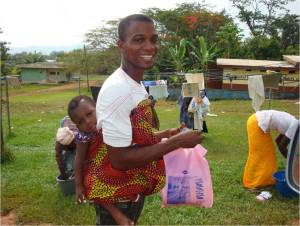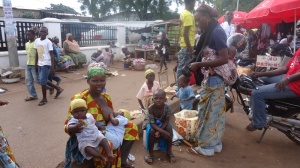Albert Oppong-Ansah, GNA Special Correspondent, from Hyderabad, India
(Courtesy, Convention on Biological Diversity Secretariat, Global Environmental Facility and Internews).
Hyderabad (India), Oct. 22 GNA-The Earth’s biological resources are vital to humanity’s economic and social development.
Human’s survival depends largely on these natural resources. Biological diversity could be described as the livings or species that found in oceans, forest, rivers and the sea which depends on each other for survival.
Professor Alfred Oteng-Yeboah, Chairman of the Biodiversity Committee explained that with urbanization and increased in population there was an extensive pressure from humanity that had resulted in the degradation of about 50 percent of the world’s biodiversity.
“Again due to the crave for wealth and good living people are exploiting these natural resource through activities like mining activities, tree felling and sand wining,” he said.
The result of these activities received a growing recognition that biological diversity is a global asset of tremendous value to present and future generations.
Not only has that but, the threat to species and ecosystems in the world has never been as great as it is today. Species extinction caused by human activities continues at an alarming rate.
Background to the establishment of COP Meetings
In response, the United Nations Environment Programme (UNEP) convened the Ad Hoc Working Group of Experts on Biological Diversity in November 1988 to explore the need for an. international convention on biological diversity.
Soon after, in May 1989, it established the Ad Hoc Working Group of Technical and Legal Experts to prepare an international legal instrument for the conservation and sustainable use of biological diversity.
The experts were to take into account “the need to share costs and benefits between developed and developing countries” as well as “ways and means to support innovation by local people”.
By February 1991, the Ad Hoc Working Group had become known as the Intergovernmental Negotiating Committee.
Its work culminated on 22 May 1992 with the Nairobi Conference for the Adoption of the Agreed Text of the Convention on Biological Diversity.
The Convention was opened for signature on 5 June 1992 at the United Nations Conference on Environment and Development (the Rio “Earth Summit”).
It remained open for signature until 4 June 1993, by which time it had received 168 signatures.
The Convention entered into force on 29 December 1993, which was 90 days after the 30th ratification.
The first session of the Conference of the Parties was scheduled for  28 November – 9 December 1994 in the Bahamas.
28 November – 9 December 1994 in the Bahamas.
The Convention on Biological Diversity was inspired by the world community’s growing commitment to sustainable development.
It represents a dramatic step forward in the conservation of biological diversity, the sustainable use of its components, and the fair and equitable sharing of benefits arising from the use of genetic resources.
Current Agreements at COP 11
Attended by about 1400, 400 participants made up of civil societies and parties to the convention the world’s governments have agreed to increase funding in support of actions to halt the rate of loss of biodiversity at the eleventh meeting of the Conference of the Parties to the United Nations Convention on Biological Diversity.
Developed countries agreed to double funding to support efforts in developing states towards meeting the internationally-agreed Biodiversity Targets, and the main goals of the Strategic Plan for Biodiversity 2011-2020.
The Saragasso Sea, the Tonga archipelago and key corals sites off the coast of Brazil are among a range of marine areas to receive special attention by governments as part of renewed efforts to sustainably manage the world’s oceans agreed in Hyderabad.
Many of the areas are beyond national jurisdictions and, as such, receive little or no protection at present.
Other key decisions taken at the 11th Conference of the Parties to the Convention on Biological Diversity (CBD COP 11) include new measures to factor biodiversity into environmental impact assessments linked to infrastructure and other development projects in marine and coastal areas.
Braulio Ferreira de Souza Dias, Executive Secretary of the Convention on Biological Diversity said: “These results, coming in a period of economic crisis, demonstrate that the world is committed to implementing the CBD.
We see that governments are moving forward in implementation and seeing biodiversity as an opportunity to be realized more than a problem to be solved.”
“We now need to move forward in the next two years, under the able leadership of India, the COP 11 president, to consolidate this work and to advance further.
I look forward to other pledges in support of the Hyderabad call for Biodiversity Champions that will allow us to realize our goals” he said.
Madam Jayanthi Natarajan, minister of Environment and Forests for India, and president of the COP said the present economic crisis should not deter parties but on the contrary encourage parties to invest more towards amelioration of the natural capital for ensuring uninterrupted ecosystem services, on which all life on earth depends.
Mr Achim Steiner Director UN Environment Programme Executive said the UN biodiversity conference in Hyderabad had taken forward the renewed momentum, forged two years ago in Nagoya.
He added that countries had sent a clear signal and delivered additional commitments underlining the fact that biodiversity and ecosystems were development priority and central to a transition to an inclusive Green Economy.
“Mobilizing the necessary financial resources from the public and private sector needed to ensure achievement of the 2020 targets remains a challenge – but here in India, many nations including developing economies have signaled their determination and sense of urgency to seize the opportunities by providing much needed additional support,” Mr. Steiner said.
Funding for Developing countries
On the on funding Developed countries agreed at the conference to increase funding to support efforts in developing states towards meeting the Aichi Biodiversity Targets.
Using a baseline figure of the average annual national spending on biodiversity between 2006 and 2010, developed countries said they would double biodiversity-related international financial flows by 2015.
The COP also set targets to increase the number of countries that have included biodiversity in their national development plans, and prepared national financial plans for biodiversity, by 2015.
All Parties agreed to substantially increase domestic expenditures for biodiversity protection over the same period.
These targets, and progress towards them, will be reviewed in 2014.
For the first time, developing countries at COP 11, including India and several African states, pledged additional funds above and beyond their core funding towards the work of the CBD.
The conference also saw the launch of the Hyderabad Call for Biodiversity Champions. The programme will accept pledges from governments and organizations in support of the Strategic Plan for Biodiversity.
The government of India this week committed over 50 million US dollars as part of the programme.
The Global Environment Facility, the financial mechanism of the Convention, for the first time, was provided with an assessment of the financial resources required to meet the needs of developing countries for implementing the Convention.
Decision on Marine Biodiversity.
The 193 Parties to the CBD agreed to classify a diverse list of marine areas, some renowned for containing ‘hidden treasures’ of the plant and animal world, as ecologically or biologically significant.
The COP agreed to transmit the results of this classification work to the United Nations General Assembly so that they can be considered by relevant UN processes linked to the United Nations Convention on Law of the Sea, in particular the United Nations General Assembly Working Group which is considering the development of an international agreement for biodiversity conservation in marine areas beyond national jurisdiction.
Parties to the Convention also called for more research into the potential adverse effects of underwater noise from ships on marine and coastal biodiversity, and highlighted the growing concern on the adverse effects of marine litter.
It also recognized the growing challenge of climate change impacts on coral reefs, which, Parties agreed, will require significant investment to overcome.
There was also a call to fisheries management bodies to play a stronger role in addressing the impacts of fisheries on biodiversity.
The series of agreements at COP 11 on oceans and coasts builds on the commitment of countries made at the United Nations Rio+20 summit in June to protect and restore marine ecosystems and to maintain their biodiversity.
Various National Biodiversity Plan.
With regards to National Biodiversity Plans much of the COP 11 negotiations revolved around practical and financial support for countries in implementing national biodiversity plans to meet the Strategic Plan for Biodiversity and the 2020 Aichi Biodiversity Targets.
In reviewing global progress in implementing such measures, the COP reaffirmed the need for enhanced technical and scientific cooperation among countries, while underlining the potential for enhanced cooperation among developing countries.
To support such efforts, a new National Biodiversity Strategies and Action Plans Forum (NBSAP Forum) was launch at COP11 by UNEP, CBD, The Global Environment Facility (GEF) and the UN Development Programme (UNDP).
The online forum provides easy-to-access, targeted information such as best practices, guidelines and learning tools for countries.
UNEP’s Economics of Ecosystems and Biodiversity (TEEB) Initiative also presented a series of practical guides for governments at COP 11 for integrating the economic, social and cultural value of ecosystems into national biodiversity plans.
COP 11 also agreed to a number of measures to engage the main economic sectors, such as business and development organizations, to integrate biodiversity objectives in their plans and programmes.
COP 11 developed new work in support of achieving Aichi Target 15 which calls for the restoration of 15% of degraded lands.
This work was supported by a call, in the margins of the meeting, by the UN Framework Convention on Climate Change (UNFCCC), the UN Convention to Combat Desertification (UNCCD) and other bodies for concerted action in support of the decision.
A decision on climate change and biodiversity called for enhanced collaboration between the CBD and UN climate change initiatives including Reducing Emissions from Deforestation and Forest Degradation (REDD+)
Given that forests are home to more than half of all terrestrial species, initiatives such as REDD+, where developing countries can receive payments for carbon offsets for their standing forests, can potentially help achieve international biodiversity targets, as well as those concerned with cutting carbon emissions.
The decision covers technical advice on the conservation of forests, sustainable management of forests, and enhancement of forest carbon stocks.
However the COP also noted discussions around the need for biodiversity safeguards relating to REDD+ and similar incentives. Actions such as afforestation in areas of high biodiversity value, or the conversion of natural forests to plantations, for example, may have adverse impacts on biodiversity.
The COP adopted recommendations for improving the sustainable use and management of species hunted for ‘bushmeat’ in tropical and sub-tropical regions, where large-scale hunting and trade of animals has led to ’empty forest syndrome’, and is increasingly threatens food security, and the ecological stability of forests and other ecosystems.
Together with FAO and other organizations, the CBD Secretariat will establish a global ‘Collaborative Partnership on Sustainable Wildlife Management’ to support developing countries in the implementation of relevant CBD provisions.
COP 11 adopted a decision on protected areas that provides a framework for achieving Aichi target 11.
It calls for integration of national action plans for Protected Areas into revised National Biodiversity Strategies and action Plans.
Participants adopted the Hyderabad Declaration on Subnational Governments, Cities and other Local Authorities for Biodiversity, which supports the work of cities to achieve the Global Strategy for Biodiversity and calls for greater coordination between levels of government.








